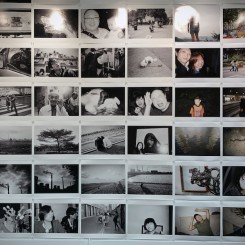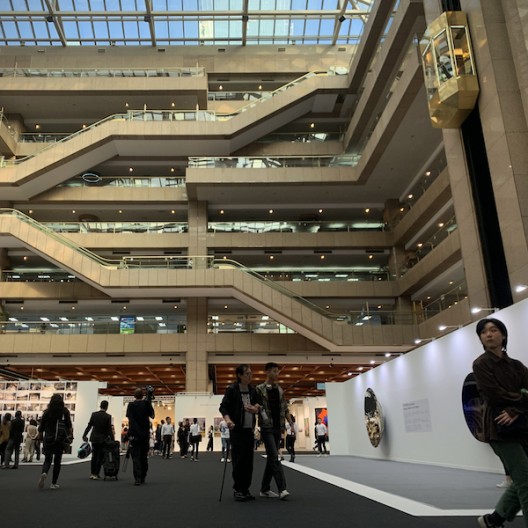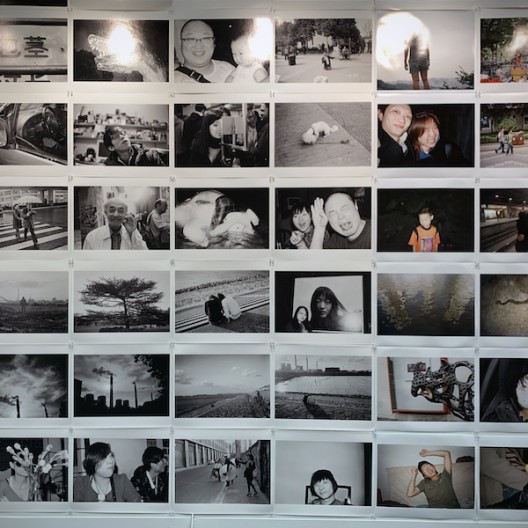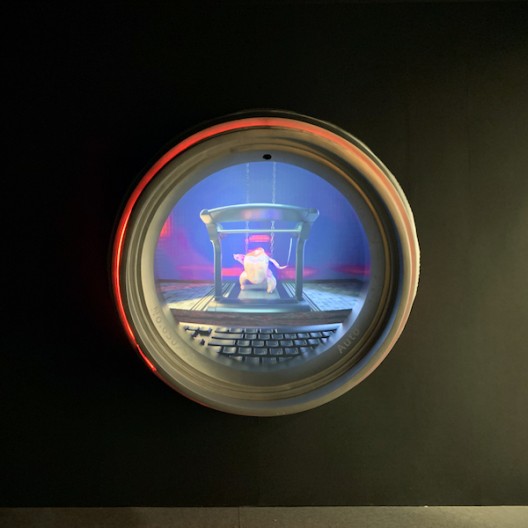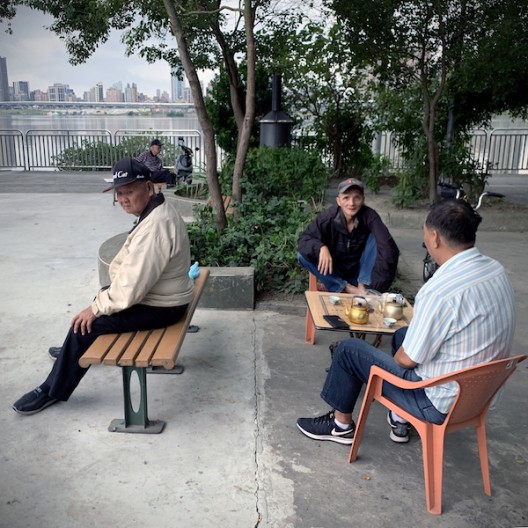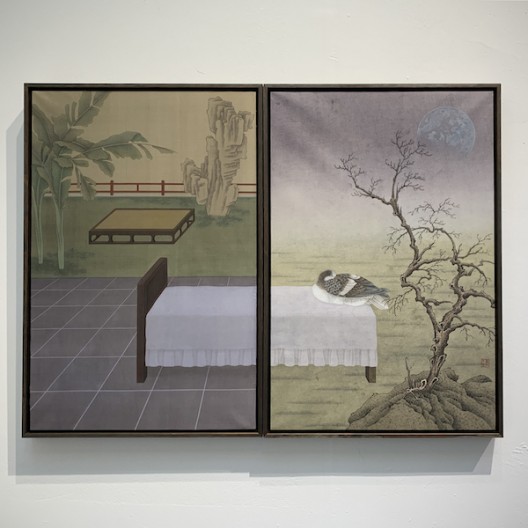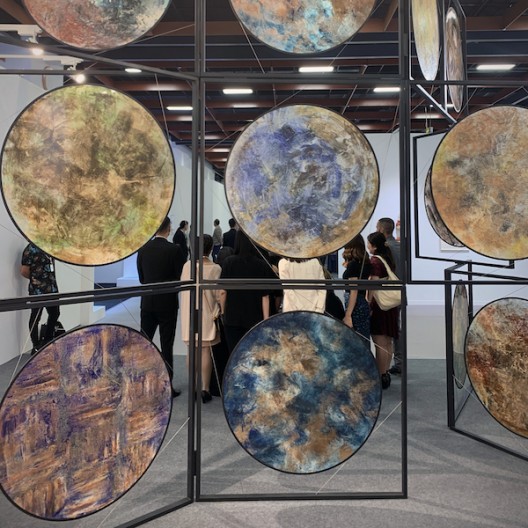by Girolamo Marri
Art Taipei
18-21 October 2019
I enter Art Taipei straight after 18 hours spent in airports and planes,I’m lacking sleep and I feel a little dizzy. For about half an hour I roam aimlessly in the exhibition space, which is set within Hall 1 of the Taipei World Trade Center, surrounded by 6 floors of concrete balustrades, exposed staircases and brass elevators, and topped by a metal and glass ceiling. i imagine I’m in some retro-future movie, where all people with a badge are in fact cyborgs programmed to sell trippy paintings with flashy colours that will spy from behind sofas and eventually control their buyers’ brains. When I turn a corner and see myself shuttered in a million shiny fragments in a mirror dish by Anish Kapoor, I find it exhilarating, but nearly lose balance and fall on the carpeted floor. Then I decide to look for some coffee before I make a fool of myself.
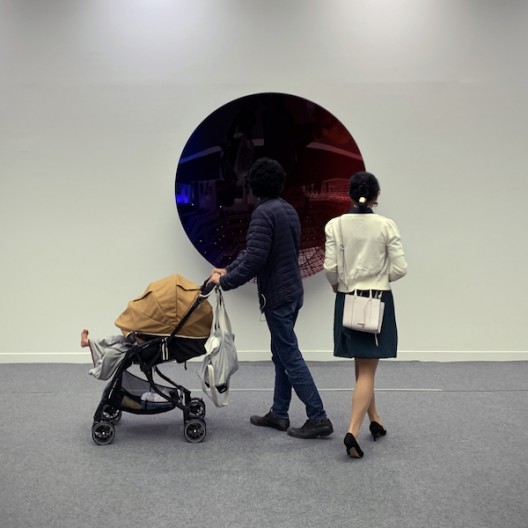
One of the two mirror sculptures presented in the section called “Homage To Maestro Anish Kapoor”, lent to the fair by a private collector as a response to Kapoor’s solo exhibition in Beijing’s Imperial Ancestral Temple Art Museum and Academy of Fine Arts Museum
Still on my way to salvation I pass in front of Shanghart’s booth and stop to say hello to director Lorenz Helbling, whom I bump into every time I set foot into a Chinese art related event anywhere around the globe.He tells me he enjoys the fair, which according to him has evolved steadily since the first time he took part in it some fifteen years ago, when artist Zhou Tiehai served to the public toilet shaped cakes.He finds that the strictly regional choice of galleries, which many might see as a fair’s shortcoming, is actually setting it apart from most other art fairs, which are dominated by the same international behemoths and end up looking the same as one another.
Lorenz’s argument is confirmed by numbers. Out of 141 galleries taking part to the fair, about 60 are from Taiwan, and the rest represent only 12 countries, mostly East Asian.And certainly Art Taipei seems to capture the local flavour and perspective. I see for example plenty of mono-ha inspired paintings and modern ink on rice paper, but no queer aesthetics or Arte Povera epigones. I can easily imagine the public connecting more with this selection of work than with those presented in other, more westernised environments.
Several minutes later I am finally emerging from the muffled depths of my semi-comatose state thanks to a cup of coffee I buy in the VIP lounge. The first thing I see with renewed awareness is a pale blue Bentley on a stand, courtesy of one of the fair sponsors. “it’s all over now Baby Blue” I hum to myself, while plunging back in the fair.
I return to Shanghart and concentrate on their booth. The walls are covered by two different photo collections by artist duo Birdhead, originally commissioned for Tokyo National Art Center. The selection of pictures is made according to no specific concept or purpose, it’s just pictures that the artists took and wanted to present together. Lorenz also shows me a few books that Birdhead published over time according to the same principle / non-principle. I find this to be the work of masters, with skill and vision so strong that they don’t need to be supported by any thematic consistency.
Seeing very few westerners at the fair’s preview, I imagine much of that crowd to be swarming in Paris for FIAC and Asia Now, happening on these same dates.I am sure it’s not easy to set your art fair dates right these days. After all, there are only 52 weeks in a year, some of which, such as Christmas, the two New Years or the hottest summer ones, are clearly not good for business. Furthermore Frieze and Art Basel are trying to open shop wherever someone has some spare money in their wallet, and hundreds of regional art fairs sprout up like mushrooms all around. Some annoying overlapping is inevitable.The high powers of the art world should push for a few more weeks to be added to the calendar. Were they tax free weeks it would be even better.
Hanging on the walls of a small booth I see freeze-frames of Japanese animes from the 70’s and 80’s. Oddly enough, in Italy most people my age grew up watching such cartoons and, entering the booth, they’d feel like they were time travelling back to their childhood. I am about to take a picture to show my friends, when a gallery assistant approaches me and asks politely not to publish the pictures on social media nor anywhere else, as the gallery doesn’t own the rights to use these images. I’d like to ask a few questions about this odd situation, but then realise the fact is in itself enough of an answer.
Fortunately, on my first, lysergic visit to the fair I miss the installations by Shenzhen based new media collective MOTSE, which might otherwise send me on a really strong acid-like trip.On my second day I instead spend forty minutes going from one room to the next and talking with two of the artists, who are eager to explain the works in detail. These speculate on the near future while being rooted in traditional Chinese culture. Everything is a little too overt and direct for my taste, yet I get carried away by the flawless technical execution and pleasant visuals and sound. The structure of the collective is also fascinating; it comprises of 40 members coming from different parts of China, all except for two brits who do the soundtracks;, all pieces are produced in-house in a workshop in Shenzhen and, with such a large number of members, many art and corporate projects are developed simultaneously. The collective just had a big show of 17 works at Powerlong Museum in Shanghai.
MOTSE’s works are presented as part of the fair’s Public Art Project section, which also includes a work by Xu Bing presented by Ink Studio. The front of Background Story: Spring Clouds and Layered Mountains appears to be a traditional ink wash landscape painting. Walking behind it one can see the work is actually made by projecting light on everyday use objects such as pieces of cloth or string. Their shadow is cast onto a translucent piece of paper in the front, creating the illusion of a multilayered painting of misty peaks and waterfalls. Well executed but not as deep and convincing as other series by the artist.
I have dinner with a couple of old friends who have been living in Taipei for seven years. They love it here, their favourite things being Taiwan’s mountains, easy to reach yet feeling remote and unspoiled, the unobtrusiveness of bureaucracy, the excellent services for locals and foreigners alike, and everyone’s typically benevolent and respectful attitude.

Could you believe a food stall selling stinky tofu could get a Michelin star? Well, it can. It is my main discovery, on my first night in Taipei (first ever!), when I venture out of the hotel to explore one of the city’s famous night markets following my stomach desperate appeals for street foo
Yet they surprise me by attacking the belief, common to most who don’t live here, that traditional Chinese culture is more alive in Taiwan than it is in the mainland. According to my friends, in an effort to set themselves apart from their ancestral homeland, the Taiwanese have in fact deliberately renounced many distinctive customs. You won’t for example see any old chap wearing mandarin collar shirts and gongfu shoes for a stroll at the park, or a girl wearing a silk qipao at a party; you’ll struggle to find reliable TCM doctors; the island’s famed wulong tea (which I happily buy and drink back in Rome), is produced mainly for export, while locals drink coffee, and so forth. While I look at them, bewildered, my friends deliver a final blow saying that in Taiwan you really don’t eat that well, and that, unlike back in Shanghai where they used to live before they moved here, few people know how to cook and most have nothing but a microwave in their kitchen, surviving on ready meals and other junk food.
Of course being in Taipei for two nights only and having to concentrate on the art fair, I have no time to confirm or refute such horrible accusations, but, believing this to be a very relevant topic, and in adherence to contemporary journalism ethics, I thought I’d report on it anyway.
Shanghai based Xu Gallery does not impress me in its entirety, I’m really not taken by the much photographed collection of fake donuts hanging on the outer wall of its booth. But I enjoy the paintings of Kong Li. I could not say that they are strikingly original or technically remarkable, but there is something in their formal composition and in their muted down colour palette that pinches my inner melancholic strings and feels very apt for this time of year. I feel even more inclined to write about the work when I learn that Kong Li is rather young and has attained no formal art education. He simply took part in a competition organised by the gallery and won it. He has then been offered a solo show that went well and now Xu Gallery, taking part in Art Taipei for the first time, is confidently showing, and apparently selling, his understated paintings.
I arrive after midnight at the party organised by the fair and Artnet, long after it begun at 10.30pm. It’s been raining a bit – as it often does in Taipei, so they had to stop the music and someone has forgotten to cover canapés which look now uninvitingly soggy. But the bartenders are pouring generously, the atmosphere is very relaxed, everyone seems to be having a good time and to know everyone else. Here as well as in the fair, I smell no envy and no frustration, neither I see pretentiousness or vanity. Not in the intoxicating quantities of other art fairs anyway. When I finally join some old familiar faces, someone says “This feels like Shanghai in 2010!” and I have to agree, it used to be like this in Shanghai back then: local, familiar, genuine, predictable yet surprising, and a bit messy.
Messy or not, the fair is certainly not unsuccessful; on the preview day alone, the fair generated TWD 36,000,000 (about USD 1,178,000).
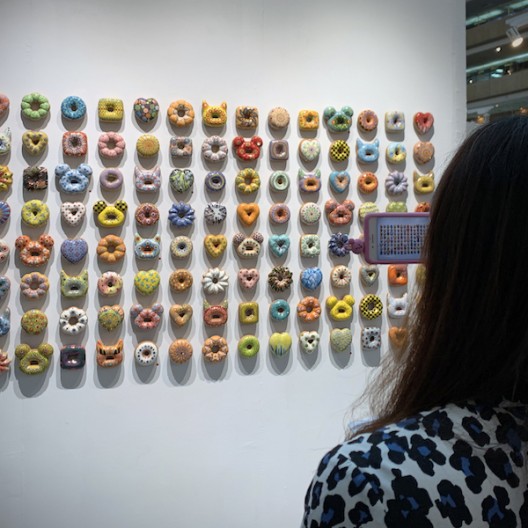
Apparently art now needs to be instagrammable. Apparently donuts are very instagrammable. Donuts are art.
The result is even more remarkable, considering there were serious practical issues to be faced in the previous weeks. As the mainland issued a ban on individual visas to Taiwan for its citizens, in order to get gallerists, collectors and journalists to come from the mainland, the fair had to pay for them to go through Macau and get social business or expert visas from there. Shipping artworks proved equally complicated and many galleries had to show only small works that could be carried in suitcases rather than shipped.
No matter the fair’s efforts to bypass the visa ban, compared to previous editions, the fair focus shifted a bit towards Malaysia and Japan, which this year are more represented than the Mainland in terms of galleries and collectors presence.
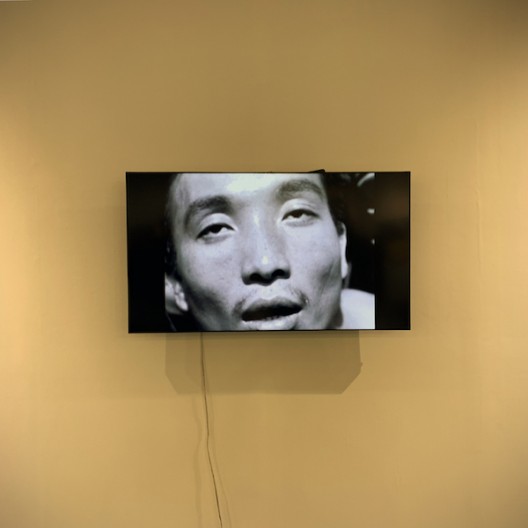
A video in “Art Revives Beyond Discipline: Post Martial-Law and the Development of Taiwan Contemporary Art” and exhibition occupying a large booth which explored the development of contemporary art in Taiwan after the end of the martial law in 1987. The show was very academic, but meaningful.
Chinghsin Chung, Chairperson of the Taiwan Art Gallery Association and director of Da Xiang Gallery, is well at ease and answers frankly to all manners of questions. I meet her on the morning of my departure there at a scheduled breakfast meeting for journalists. Again I’m not in the best of shapes, so I stuff my plate with eggs and dumplings, sit back and parasitically let other journalists ask clever questions.
Most of the conversation is about the difficult relation with Dangdai. Ms. Chung does neither hide or overstate her diffidence towards the newcomers when she tells us they made no real effort to create a proper dialogue with the existing fair and did not even consider the possibility of hosting the fairs on the same dates. Dangdai will happen in January, at an odd moment, very close to Taiwan’s elections as well as Chinese New Year. She also finds that Dangdai does not reflect very well what Taiwan’s art scene has to offer, as it only accepts the 20% of local galleries generating the highest revenue. She defends Art Taipei’s acceptance of all Taiwan’s galleries that want to showcase their art.
Once again I’m drawn to reflect on Art Taipei’s militant localism, but this time I reason that if the selection of galleries was a little tighter, the overall quality of the work, which is currently not up to high standards, would certainly improve.And anyway Art Taipei is at its 26th consecutive edition, and it’s the oldest fair in Asia, so I think it can benefit from a bit of healthy competition, as a means to rejuvenate itself and state more clearly its focus.
A few hours later, waiting for a fish ball soup In Hong Kong airport before I catch my connecting flight back to Rome, I briefly note down my impression of Art Taipei. “It’s both very young, with the insecurities and optimism of an adolescent, and very old, with the relaxed attitude of someone who has seen a lot and is a pinch senile”.

